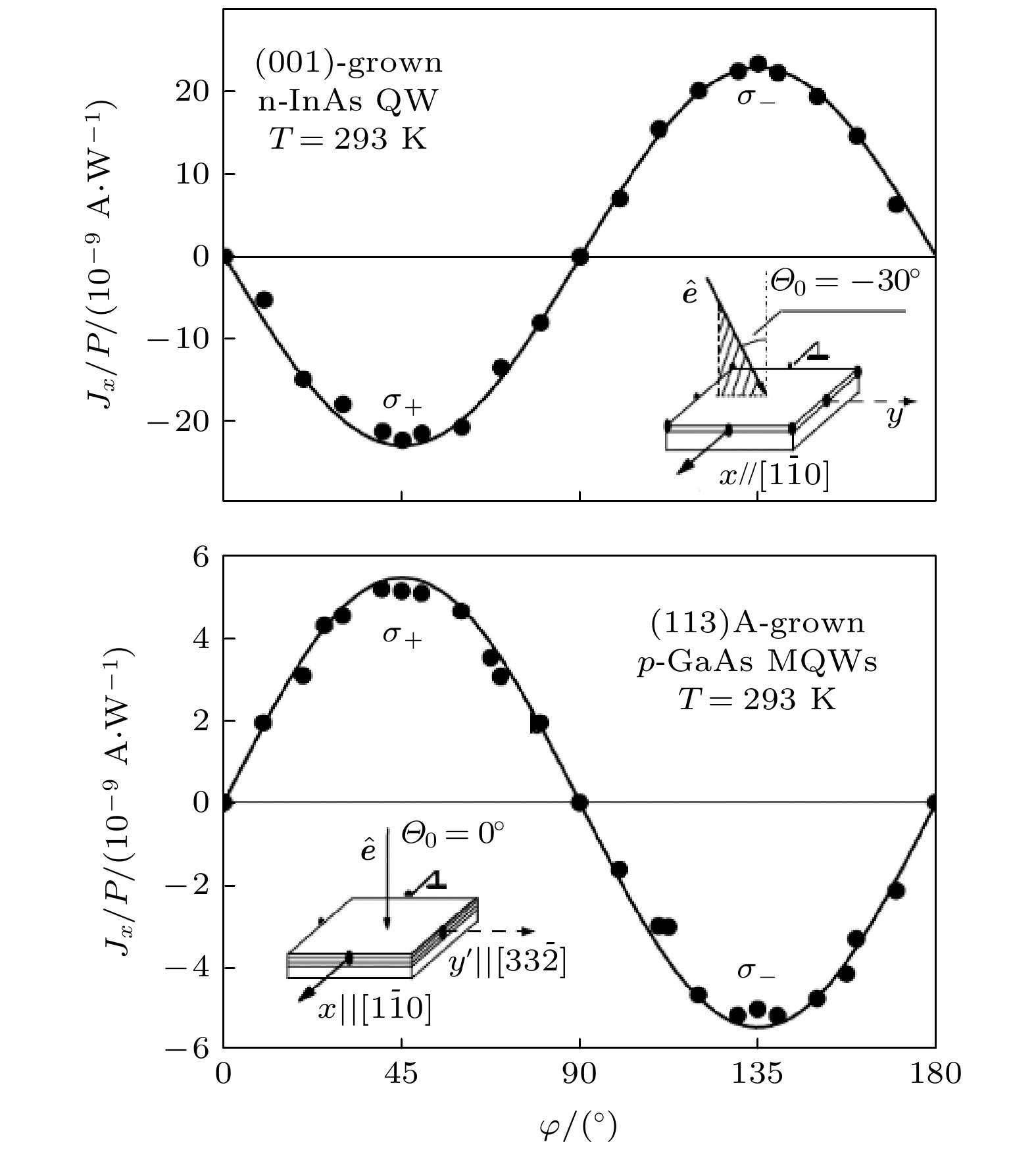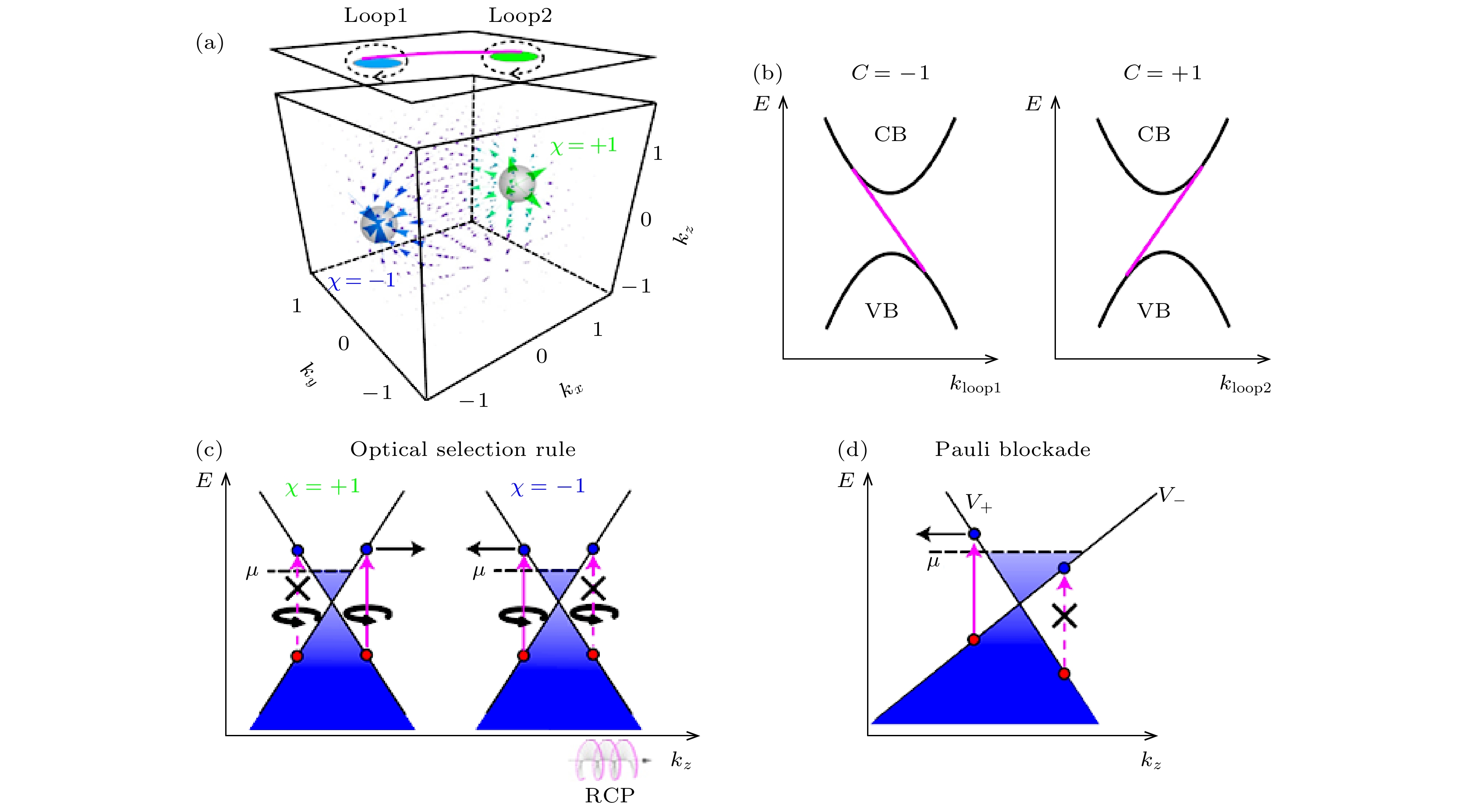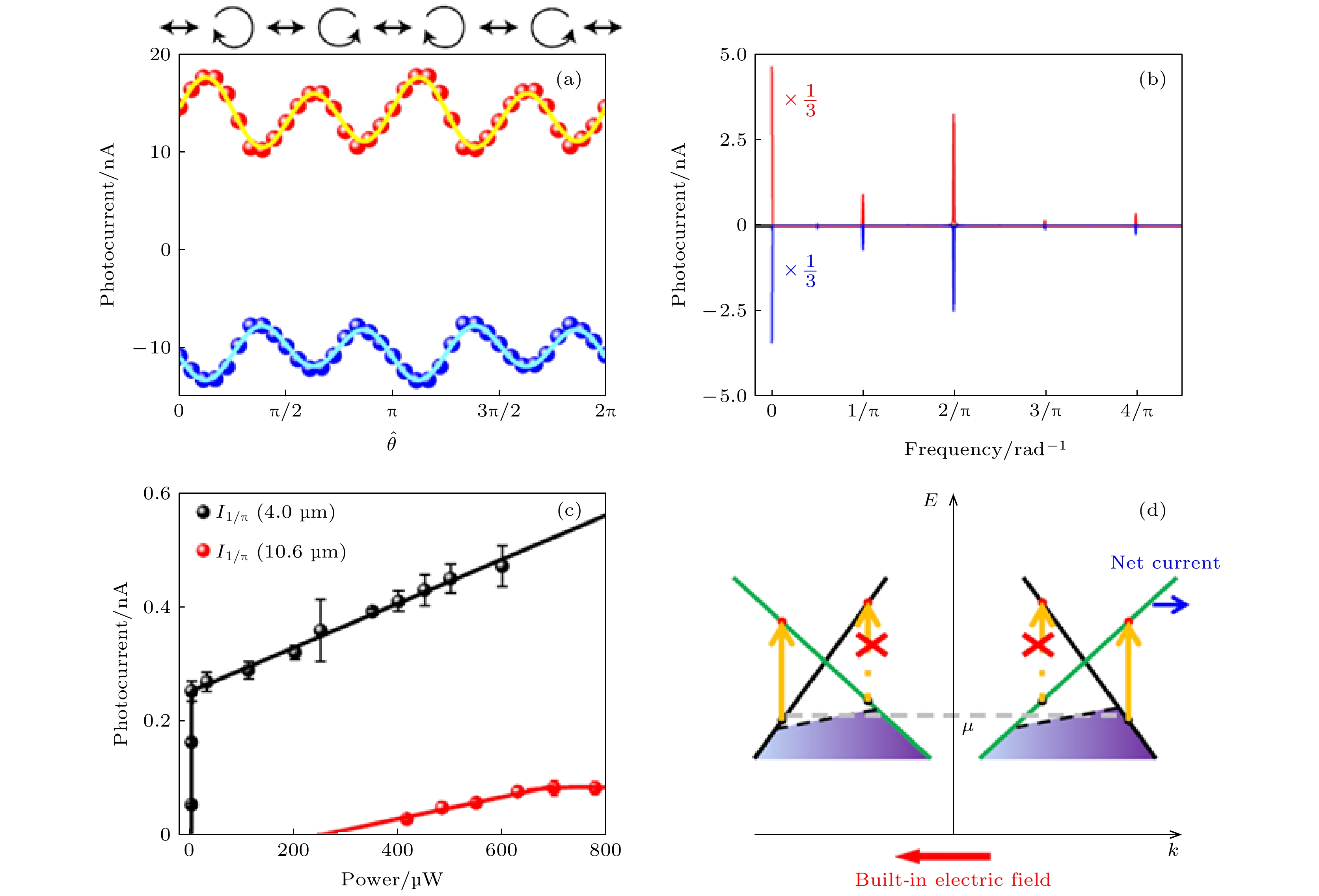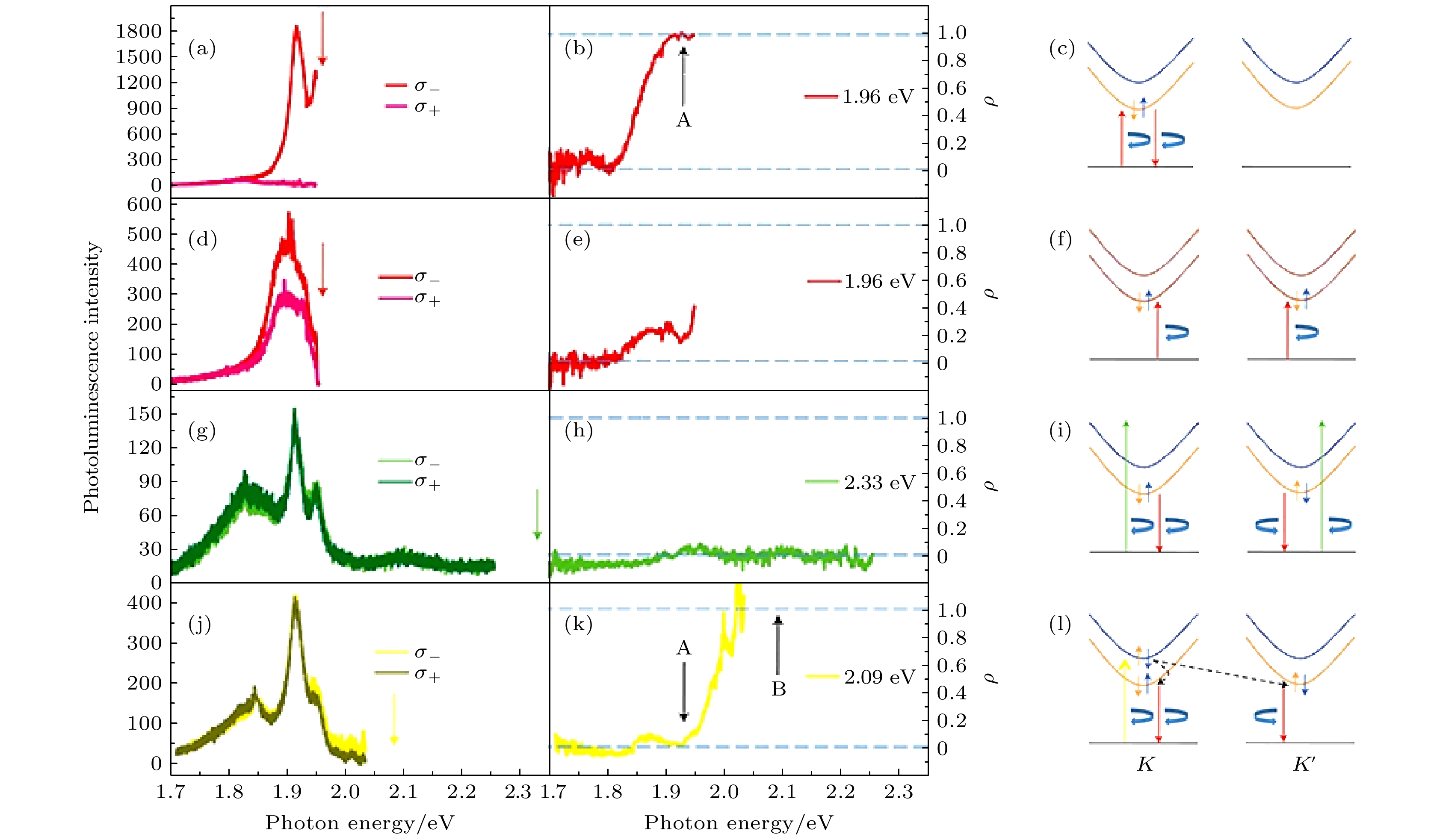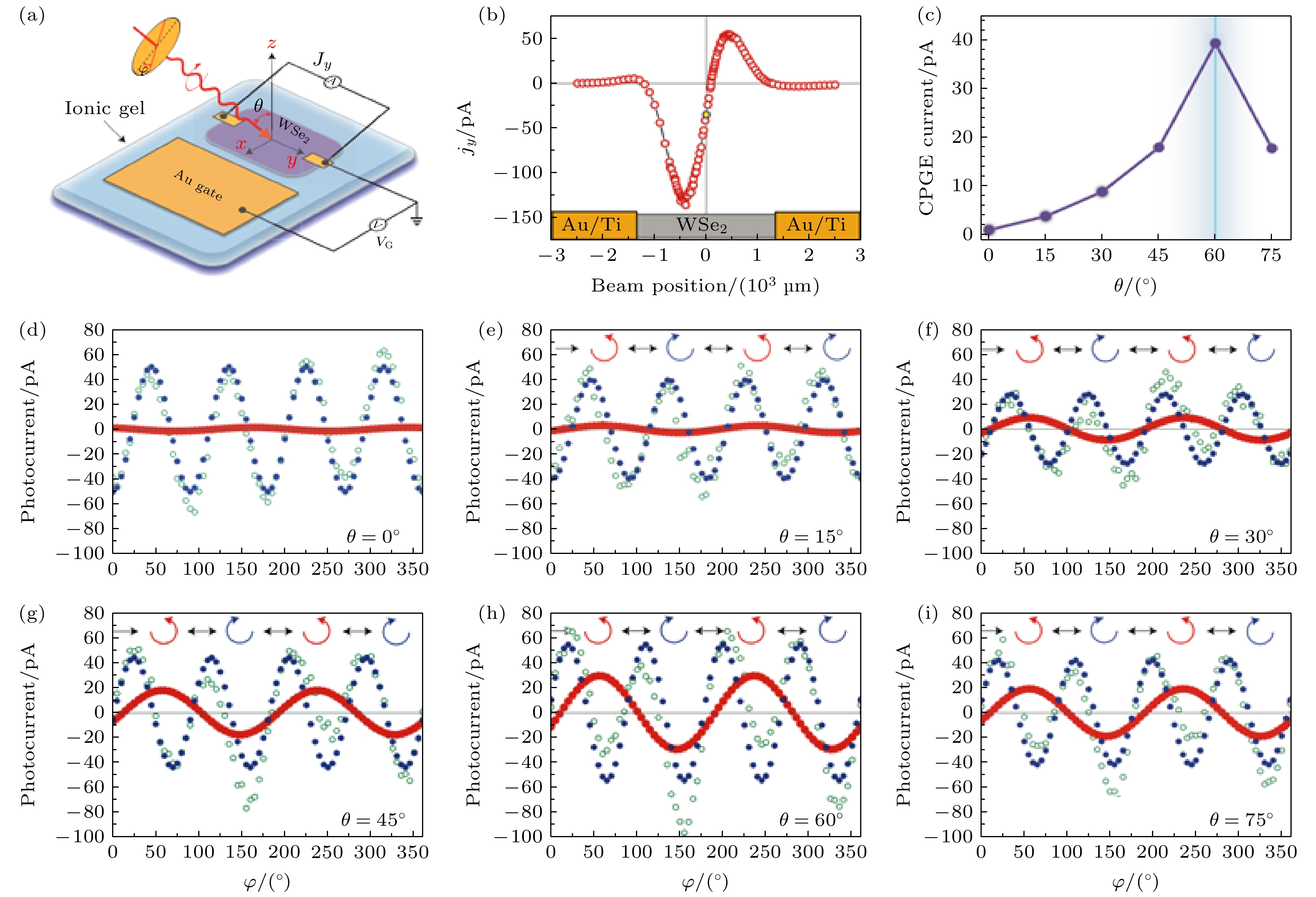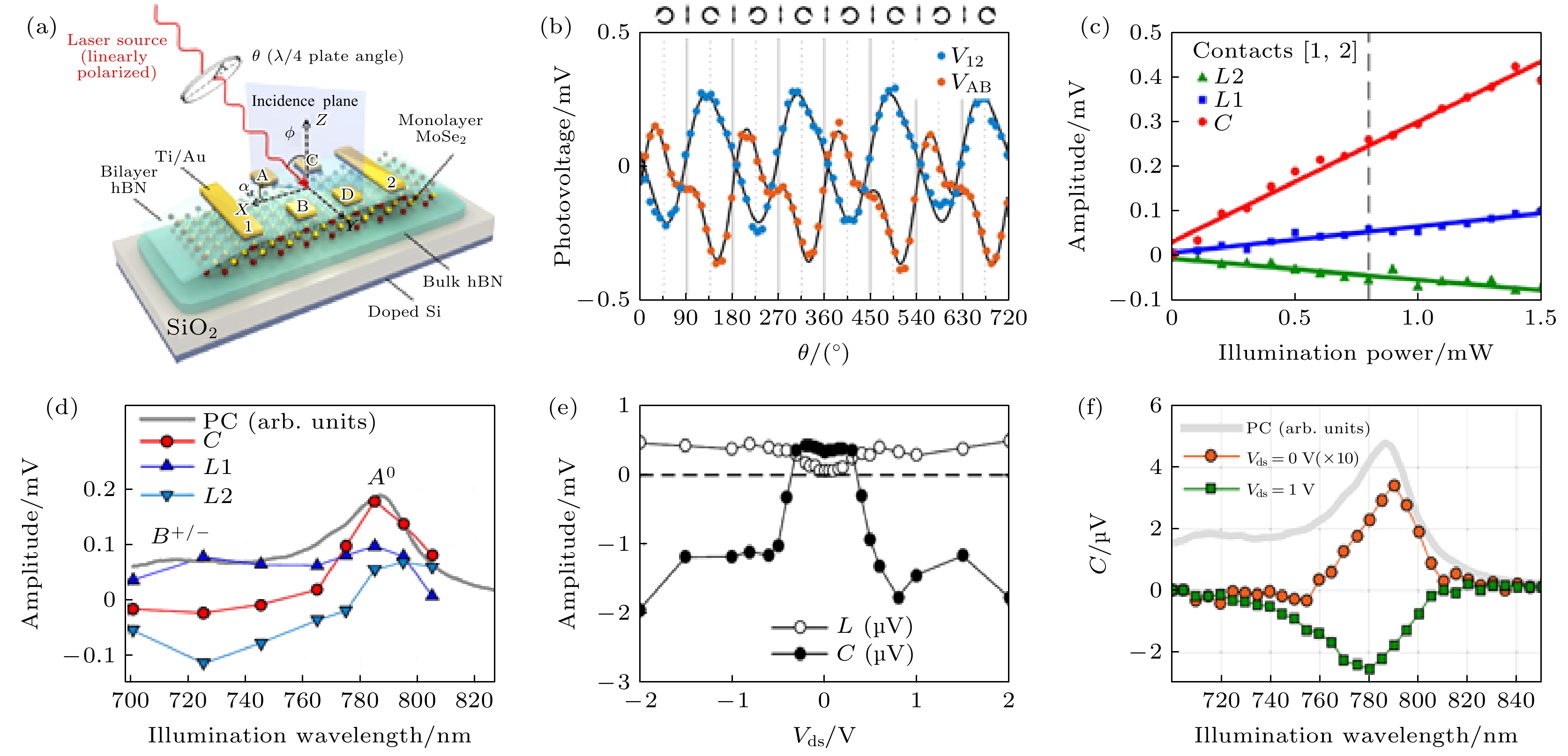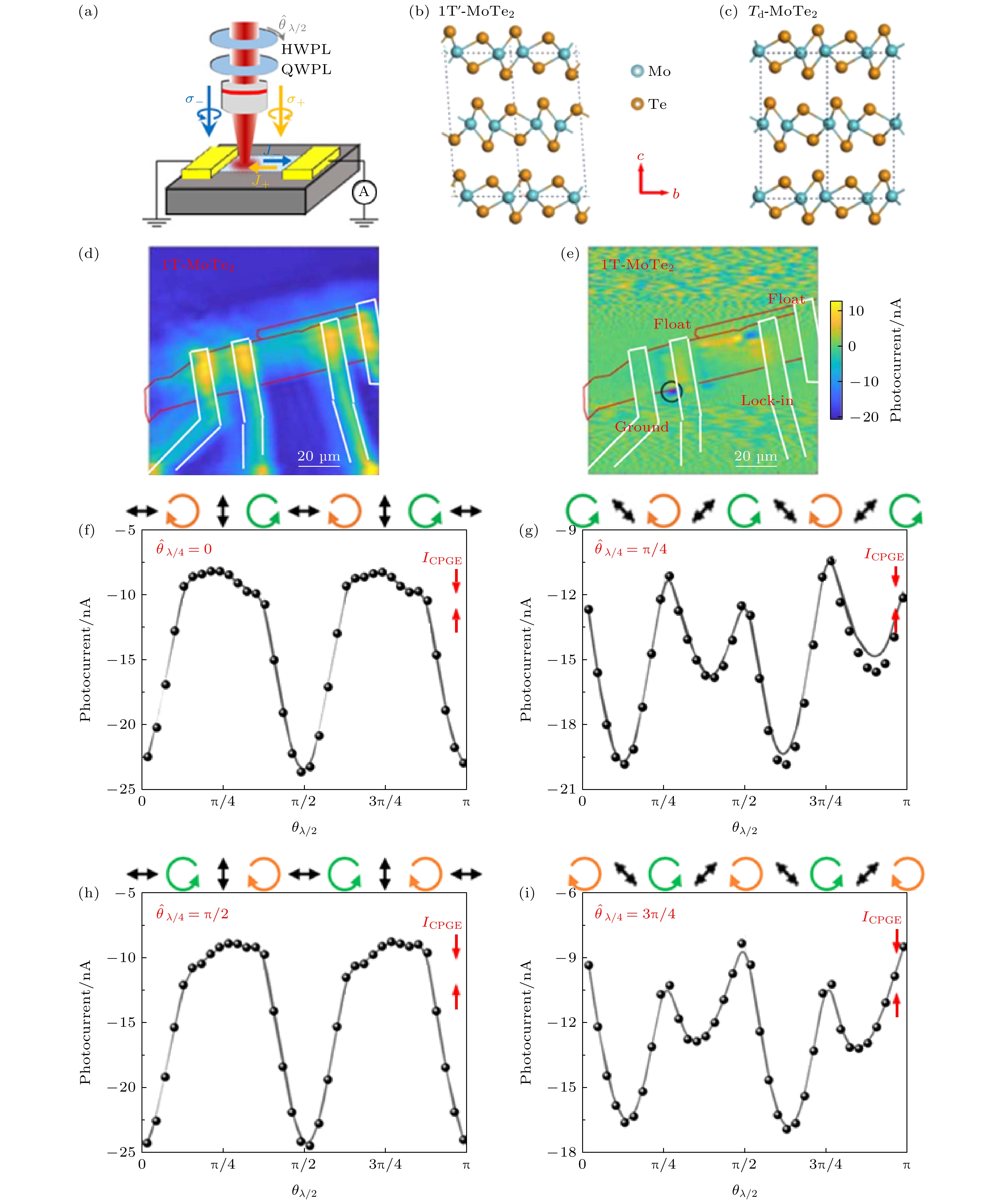-
自旋电子学和谷电子学作为半导体物理的新方向, 旨在利用电子的自旋和谷自由度来实现新型的逻辑运算和信息处理. 圆偏振光伏效应是近年来研究自旋电子学和谷电子学的重要实验手段, 也是实现新型的自旋与谷存储器件的一个可能的方式, 为下一代的器件信息的处理方法提出了一种新的可能. 圆偏振光伏效应是一种二阶非线性光电响应, 是指材料在圆偏振光的激发下产生随偏振角度变化的光电流. 光电流的产生依赖于自旋、谷极化、对称性以及Berry曲率等诸多因素, 可以揭示出材料深层次的物理性质. 本篇综述主要讨论了在不同材料体系产生圆偏振光伏效应的主要机制, 包括在半导体异质结由对称性破缺导致的Rashba自旋轨道耦合引起的圆偏振光电流, 以及拓扑 Weyl半金属由Berry曲率以及泡利阻塞造成的电子动量选择, 以及二维层状过渡金属硫化物中圆偏振光产生的谷极化电流等. 在此基础上, 本文还简略介绍了一些新型二维材料中的圆偏振光伏效应的可能实现的方式, 以及一些潜在的应用.The spin and valley degree of freedom are a novel way to extend the functionalities of spintronic and valleytronic devices. A traditional, room-temperature way of examining the spin polarization generates the photocurrent whose magnitude and polarity depend on chirality of induced optical excitation. The circularly polarized photovoltaic effect is a kind of second-order nonlinear photoelectric response, which means that the photocurrent generated varies with the polarization angle of circularly polarized light. The generation of photocurrent depends on many factors such as spin, valley polarization, symmetry and Berry curvature, so it can reveal the fundamental physical properties of materials. In this review, we discuss the main mechanisms of circularly polarized photovoltaic effect in different material systems, including circularly polarized optical current caused by symmetry breakdown of Rashba spin-orbit coupling in semiconductor heterojunction, the electron momentum selection caused by Berry curvature and Pauli blocking in topological Weyl semimetals, and the valley polarization current generated by circularly polarized light in TMDC. Additionally, the recent progress of applications of circular photogalvanic effect is also presented.
-
Keywords:
- circular photogalvanic effect /
- Rashba effect /
- spin polarized /
- Berry curvature
[1] Watanabe H, Yanase Y 2021 Phys. Rev. X 11 011001
 Google Scholar
Google Scholar
[2] Ivchenko E L, Pikus G E 1978 ZhETF Pisma Redaktsiiu 27 640
[3] Belinicher V I 1978 Phys. Lett. A 66 213
 Google Scholar
Google Scholar
[4] Ganichev S D, Ivchenko E L, Danilov S N, Eroms J, Wegscheider W, Weiss D, Prettl W 2001 Phys. Rev. Lett. 86 4358
 Google Scholar
Google Scholar
[5] Ganichev S D, Prettl W 2003 J. Phys. Condens. Matter 15 R935
 Google Scholar
Google Scholar
[6] Ma Q, Xu S Y, Chan C K, Zhang C L, Chang G, Lin Y, Xie W, Palacios T, Lin H, Jia S, Lee P A, Jarillo-Herrero P, Gedik N 2017 Nat. Phys. 13 842
 Google Scholar
Google Scholar
[7] Yuan H, Wang X, Lian B, Zhang H, Fang X, Shen B, Xu G, Xu Y, Zhang S-C, Hwang H Y, Cui Y 2014 Nat. Nanotechnol. 9 851
 Google Scholar
Google Scholar
[8] Weyl H 1929 Z. Phys. 56 330
 Google Scholar
Google Scholar
[9] McEuen P L, Bockrath M, Cobden D H, Yoon Y G, Louie S G 1999 Phys. Rev. Lett. 83 5098
 Google Scholar
Google Scholar
[10] Wan X, Turner A M, Vishwanath A, Savrasov S Y 2011 Phys. Rev. B 83 205101
 Google Scholar
Google Scholar
[11] Burkov A A, Balents L 2011 Phys. Rev. Lett. 107 127205
 Google Scholar
Google Scholar
[12] Huang S M, Xu S Y, Belopolski I, Lee C C, Chang G, Wang B, Alidoust N, Bian G, Neupane M, Zhang C, Jia S, Bansil A, Lin H, Hasan M Z 2015 Nat. Commun. 6 7373
 Google Scholar
Google Scholar
[13] Weng H, Fang C, Fang Z, Bernevig B A, Dai X 2015 Phys. Rev. X 5 011029
 Google Scholar
Google Scholar
[14] Xu S Y, Belopolski I, Alidoust N, Neupane M, Bian G, Zhang C, Sankar R, Chang G, Yuan Z, Lee C C, Huang S M, Zheng H, Ma J, Sanchez D S, Wang B, Bansil A, Chou F, Shibayev P P, Lin H, Jia S, Hasan M Z 2015 Science 349 613
 Google Scholar
Google Scholar
[15] Lü B Q, Xu N, Weng H M, Ma J Z, Richard P, Huang X C, Zhao L X, Chen G F, Matt C E, Bisti F, Strocov V N, Mesot J, Fang Z, Dai X, Qian T, Shi M, Ding H 2015 Nat. Phys. 11 724
 Google Scholar
Google Scholar
[16] Yang L X, Liu Z K, Sun Y, Peng H, Yang H F, Zhang T, Zhou B, Zhang Y, Guo Y F, Rahn M, Prabhakaran D, Hussain Z, Mo S K, Felser C, Yan B, Chen Y L 2015 Nat. Phys. 11 728
 Google Scholar
Google Scholar
[17] Belopolski I, Xu S Y, Sanchez D S, Chang G, Guo C, Neupane M, Zheng H, Lee C C, Huang S M, Bian G, Alidoust N, Chang T R, Wang B, Zhang X, Bansil A, Jeng H T, Lin H, Jia S, Hasan M Z 2016 Phys. Rev. Lett. 116 066802
 Google Scholar
Google Scholar
[18] Jia S, Xu S Y, Hasan M Z 2016 Nat. Mater. 15 1140
 Google Scholar
Google Scholar
[19] Parameswaran S A, Grover T, Abanin D A, Pesin D A, Vishwanath A 2014 Phys. Rev. X 4 031035
 Google Scholar
Google Scholar
[20] Murakami S 2007 New J. Phys. 9 356
 Google Scholar
Google Scholar
[21] Lü B Q, Xu N, Weng H M, Ma J Z, Richard P, Huang X C, Zhao L X, Chen G F, Matt C E, Bisti F, Strocov V N, Mesot J, Fang Z, Dai X, Qian T, Shi M, Ding H 2015 Nature Physics 11 724
[22] Xiong J, Kushwaha S K, Liang T, Krizan J W, Hirschberger M, Wang W, Cava R J, Ong N P 2015 Science 350 413
 Google Scholar
Google Scholar
[23] Zhang C L, Xu S Y, Belopolski I, Yuan Z, Lin Z, Tong B, Bian G, Alidoust N, Lee C C, Huang S M, Chang T R, Chang G, Hsu C H, Jeng H T, Neupane M, Sanchez D S, Zheng H, Wang J, Lin H, Zhang C, Lu H Z, Shen S Q, Neupert T, Hasan M Z, Jia S 2016 Nat. Commun. 7 10735
 Google Scholar
Google Scholar
[24] Huang X, Zhao L, Long Y, Wang P, Chen D, Yang Z, Liang H, Xue M, Weng H, Fang Z, Dai X, Chen G 2015 Phys. Rev. X 5 031023
 Google Scholar
Google Scholar
[25] Lü B Q, Weng H M, Fu B B, Wang X P, Miao H, Ma J, Richard P, Huang X C, Zhao L X, Chen G F, Fang Z, Dai X, Qian T, Ding H 2015 Phys. Rev. X 5 031013
 Google Scholar
Google Scholar
[26] Chan C K, Lindner N H, Refael G, Lee P A 2017 Phys. Rev. B 95 041104
 Google Scholar
Google Scholar
[27] Taguchi K, Imaeda T, Sato M, Tanaka Y 2016 Phys. Rev. B 93 201202
 Google Scholar
Google Scholar
[28] Ishizuka H, Hayata T, Ueda M, Nagaosa N 2016 Phys. Rev. Lett. 117 216601
 Google Scholar
Google Scholar
[29] Morimoto T, Zhong S, Orenstein J, Moore J E 2016 Phys. Rev. B 94 245121
 Google Scholar
Google Scholar
[30] de Juan F, Grushin A G, Morimoto T, Moore J E 2017 Nat. Commun. 8 15995
 Google Scholar
Google Scholar
[31] Sodemann I, Fu L 2015 Phys. Rev. Lett. 115 216806
 Google Scholar
Google Scholar
[32] Chan C K, Lee P A, Burch K S, Han J H, Ran Y 2016 Phys. Rev. Lett. 116 026805
 Google Scholar
Google Scholar
[33] Chen Y, Wu S, Burkov A A 2013 Phys. Rev. B 88 125105
 Google Scholar
Google Scholar
[34] Hosur P, Qi X L 2015 Phys. Rev. B 91 081106
 Google Scholar
Google Scholar
[35] Goswami P, Sharma G, Tewari S 2015 Phys. Rev. B 92 161110
 Google Scholar
Google Scholar
[36] Ma J, Pesin D A 2015 Phys. Rev. B 92 235205
 Google Scholar
Google Scholar
[37] Xu X, Yao W, Xiao D, Heinz T F 2014 Nat. Phys. 10 343
 Google Scholar
Google Scholar
[38] Mak K F, Shan J 2016 Nat. Photonics 10 216
 Google Scholar
Google Scholar
[39] Murakami S 2007 New Journal of Physics 9 356
[40] Yu R, Weng H, Fang Z, Ding H, Dai X 2016 Phys. Rev. B 93 205133
 Google Scholar
Google Scholar
[41] Ma J, Gu Q, Liu Y, Lai J, Yu P, Zhuo X, Liu Z, Chen J H, Feng J, Sun D 2019 Nat. Mater. 18 476
 Google Scholar
Google Scholar
[42] Berry M V 1984 Proc. R. Soc. London, Ser. A 392 45
 Google Scholar
Google Scholar
[43] Thouless D J, Kohmoto M, Nightingale M P, den Nijs M 1982 Phys. Rev. Lett. 49 405
 Google Scholar
Google Scholar
[44] Xiao D, Shi J, Niu Q 2005 Phys. Rev. Lett. 95 137204
 Google Scholar
Google Scholar
[45] Haldane F D M 1988 Phys. Rev. Lett. 61 2015
 Google Scholar
Google Scholar
[46] Moore J E, Orenstein J 2010 Phys. Rev. Lett. 105 026805
 Google Scholar
Google Scholar
[47] Liu J, Xia F, Xiao D, Garcia de Abajo F J, Sun D 2020 Nat. Mater. 19 830
 Google Scholar
Google Scholar
[48] de Juan F, Grushin A G, Morimoto T, Moore J E 2017 Nature Communications 8 15995
[49] Mak K F, He K L, Shan J, Heinz T F 2012 Nat. Nanotechnol. 7 494
 Google Scholar
Google Scholar
[50] Xiao D, Yao W, Niu Q 2007 Phys. Rev. Lett. 99 236809
 Google Scholar
Google Scholar
[51] Yao W, Xiao D, Niu Q 2008 Phys. Rev. B 77 235406
 Google Scholar
Google Scholar
[52] Mak K F, Lee C, Hone J, Shan J, Heinz T F 2010 Phys. Rev. Lett. 105 136805
 Google Scholar
Google Scholar
[53] Splendiani A, Sun L, Zhang Y, Li T, Kim J, Chim C Y, Galli G, Wang F 2010 Nano Lett. 10 1271
 Google Scholar
Google Scholar
[54] Lebegue S, Eriksson O 2009 Phys. Rev. B 79 115409
 Google Scholar
Google Scholar
[55] Li T, Galli G 2007 J. Phys. Chem. C 111 16192
 Google Scholar
Google Scholar
[56] Mattheis.Lf 1973 Phys. Rev. B 8 3719
 Google Scholar
Google Scholar
[57] Xiao D, Liu G-B, Feng W, Xu X, Yao W 2012 Phys. Rev. Lett. 108 196802
 Google Scholar
Google Scholar
[58] Yuan H, Wang X, Lian B, Zhang H, Fang X, Shen B, Xu G, Xu Y, Zhang S C, Hwang H Y, Cui Y 2014 Nature Nanotechnology 9 851
[59] Quereda J, Ghiasi T S, You J S, van den Brink J, van Wees B J, van der Wal C H 2018 Nat. Commun. 9 3346
 Google Scholar
Google Scholar
[60] Xu S Y, Ma Q, Shen H, Fatemi V, Wu S, Chang T R, Chang G, Valdivia A M M, Chan C K, Gibson Q D, Zhou J, Liu Z, Watanabe K, Taniguchi T, Lin H, Cava R J, Fu L, Gedik N, Jarillo-Herrero P 2018 Nat. Phys. 14 900
 Google Scholar
Google Scholar
[61] Ma J C, Muniz R A, Qi S M, Lai J W, Zhang K N, Liu Y N, Zhuo X, Chen S X, Chen J H, Zhou S Y, Sun D 2021 2 D Mater. 8 025016 7
 Google Scholar
Google Scholar
[62] Gao Y, Zhang Y, Xiao D 2020 Phys. Rev. Lett. 124 077401
 Google Scholar
Google Scholar
[63] Dhara S, Mele E J, Agarwal R 2015 Science 349 726
 Google Scholar
Google Scholar
-
图 1 光电流响应产生的两个主要过程的示意图[1] (a) 电子空穴对产生; (b) 产生的成对电荷具有方向性, 对电子和空穴有选择性整流, 从而在动量空间产生群速度的差异; (c) 实空间中对于转移电流(shift currents)和回旋电流(gyration currents)的电子波包位置移动
Fig. 1. Schematic picture of the two processes causing the photocurrent response[1]: (a) Electron-hole pair creation; (b) alternating rectification of paired charges by the director. There are two kinds of directors. The group velocity difference for the injection currents (momentum space picture); (c) the positional shift of wave packets for the shift and gyration currents (real space picture).
图 2 量子阱中的光电流作为相位角w的函数, 相位角决定了螺旋度, 光电流由光功率P归一化,
$ {\sigma }_{+} $ 和$ {\sigma }_{-} $ 表示携带角动量量子数为+1和–1的光子, 分别对应于右旋偏振光和左旋偏振光[5]Fig. 2. Photocurrent in QWs normalized by the light power P as a function of the phase angle w defining helicity.
$ {\sigma }_{+} $ and$ {\sigma }_{-} $ represent the photon with angular momentum quantum number are +1 and –1, corresponding to right-hand circular polarization light and left-hand circular polarization light, respectively[5].图 3 描述自旋极化光电流来源的微观模型 (a) 价带和导带的带间直接跃迁; (b) 导带子带能级量化的导带带内跃迁; (c) 带内德鲁特(Drude)间接跃迁
Fig. 3. Microscopic picture describing the origin of spin polarized photocurrents: (a) Interband transition between the valence and conduction band; (b) intraband transition between size-quantized subbands in the conduction band; (c) indirect (Drude) transitions.
图 4 TaAs中的手性相关的Weyl费米子的光跃迁[6] (a) 动量空间中两个手性相反的Weyl费米子的示意图, 蓝色和绿色箭头表示动量空间中Berry曲率, 灰色球体代表包裹Weyl点的费米面; (b) 表面布里渊区沿着(a)中虚线的能带结构, 对应于(a)中虚线圆; (c) 两个手性相反的Weyl锥的光选择过程; (d) 倾斜Weyl锥在泡利阻塞和有限化学势下的光跃迁过程, 节点的泡利阻塞是反对称的
Fig. 4. Chirality-dependent optical transition of Weyl fermions in TaAs[6]: (a) The blue and green arrows depict the Berry curvatures in momentum space. The grey spheres represent the Fermi surfaces that enclose the Weyl nodes; (b) band structures along the closed k loops in the surface Brillouin zone(BZ) defined by the dashed circles in Figure (a); (c) Chirality selection rule in Weyl node; (d) in the presence of a finite tilt and a finite chemical potential away from the Weyl node, the Pauli blockade becomes asymmetric about the nodal point.
图 5 TaAs中的手性相关的光电流[6] (a) 中红外光电微区测试的示意图, 使用10 mW的激光; (b) TaAs样品的光学照片. a, b, c三个方向标注在了图上. 比例尺: 300 μm; (c), (d) 10 K下沿着
$\hat{b}\left(c\right), \hat{c}\left(d\right)$ 方向的圆偏振光电流, 激光分别沿着平行(c)和垂直(d)方向. 黑色、红色和蓝色圆点分别与(b)中的位置对应. LCP为左旋偏振光, RCP为右旋偏振光Fig. 5. Observation of chirality-dependent photocurrent in TaAs[6]: (a) Schematic illustration of the mid-IR photocurrent microscope setup. We used a laser power about 10 mW throughout the main text; (b) a photograph of the measured TaAs sample. The crystal axes a, b, c are denoted. Scale bar: 300 μm ; (c), (d) polarization-dependent photocurrents at T=10 K measured along the
$\hat{b}\left(c\right), \hat{c}\left(d\right)$ direction with the laser applied at the horizontally (c) or vertically (d) aligned pink, black and blue dots in Figure (b). LCP, left-handed circularly polarized. RCP, right-handed circularly polarized.图 6 TaIrTe的圆偏振光伏效应[41] (a) 光电流响应, 1/4波片快轴与入射光偏振方向的夹角为自变量; (b) 从
$\hat{\theta }$ 空间到角频率空间的傅里叶变换; (c) 10.6和 4.0 μm激发下光电流$ {I}_{1/\mathrm{\pi }} $ 的功率依赖; (d) 动量空间中一对Weyl锥的手性选择规则和CPGE响应示意图. 灰虚线表示未施加内置电场的费米能级μ, 红色十字标志着禁止的跃迁Fig. 6. Circular photogalvanic response of TaIrTe[41]: (a) Photocurrent response as a function of the angle of the fast axis of the quarter-waveplate with respect to the polarization orientation of the incident light; (b) Fourier transform from
$\hat{\theta }$ space to the angular frequency space; (c) power dependence of$ {I}_{1/\mathrm{\pi }} $ under 10.6 and 4.0 μm excitations, respectively; (d) schematics of the chiral selection rule and CPGE response from a pair of Weyl cones in momentum space. The grey dashed line denotes the Fermi level μ without applying a built-in electric field. Red crosses mark the forbidden transitions.图 8 单层MoS2 ((a)—(c))和双层MoS2 ((d)—(f))的在K谷和K' 谷的原子层结构和电子跃迁[49] (a) 单层MoS2的蜂窝状晶格结构, 空间反演对称性明显被打破; (b) 由总角动量的z分量标记的导带最低点和价带最高点, 自旋轨道耦合提高了价带边缘处的自旋简并度. 谷自由度和旋转自由度是耦合的; (c) 圆偏振光在两谷A和B激子态的光学选择规则; (d) 双层MoS2原子Bernal堆积; (e) 通过空间反转和时间反转对称, 价带自旋简并; (f) 双层二硫化钼的光吸收, 在圆极化激发下, 两个谷是等价的, 只产生净自旋取向
Fig. 8. Atomic structure and electronic structure at the K and K' valleys of monolayer ((a)−(c)) and bilayer ((d)−(f)) MoS2[49]: (a) The honeycomb lattice structure of monolayer MoS2. Spatial inversion symmetry is explicitly broken; (b) the lowest-energy conduction bands and the highest-energy valence bands labelled by the z-component of their total angular momentum. The spin degeneracy at the valence-band edges is lifted by the spin–orbit interactions. The valley and spin degrees of freedom are coupled; (c) optical selection rules for the A and B exciton states at two valleys for circularly polarized light; (d) bilayer MoS2 with Bernal stacking; (e) spin degeneracy of the valence bands is restored by spatial inversion and time-reversal symmetries. Valley and spin are decoupled; (f) optical absorption in bilayer MoS2. Under circularly polarized excitation both valleys are equally populated and only a net spin orientation is produced.
图 9 光控制单层MoS2的谷自旋极化[49] (a)—(c) 单层MoS2在1.96 eV (633 nm)激发, A激子共振; (d)—(f) 1.96 eV时双层MoS2的激发; (g)—(i) 在2.33 eV (532 nm)下激发单层, 与A, B激子均非共振; (j)—(l) 在2.09 eV (594 nm)下激发单层, 与B激子共振. 左列: σ–和σ+-分辨光致发光光谱. 中间柱: 相应的光致发光极化率作为光子能量的函数. 右柱:光学吸收和发射过程的示意图
Fig. 9. Optical control of valley-spin polarization in monolayer MoS2[49]: (a)−(c) Excitation of monolayer MoS2 at 1.96 eV (633 nm), on resonance with the A exciton; (d)−(f) excitation of bilayer MoS2 at 1.96 eV; (g)−(i) Excitation of monolayer at 2.33 eV (532 nm), off resonance with both the A and B exciton; (j)−(l) excitation of monolayer at 2.09 eV (594 nm), on resonance with the B exciton. Left column: σ– and σ+-resolved photoluminescence spectra. Middle column: corresponding photoluminescence helicity as a function of photon energy. Right column: schematic representation of optical absorption and emission processes.
图 10 双层WSe2的晶体管示意图和与角度相关的CPGE测量[58] (a) 离子液体栅控双层WSe2晶体管结构示意图; (b) 在零偏压WSe2晶体管器件中激光点位置依赖的光电流,固定偏振的激光在两个电极(底下的黄色矩形)之间扫描; (c) CPGE光电流与入射角θ的关系; (d)—(i) 在不同入射角θ下, 在y = 0处测量的偏置WSe2晶体管中光电流的光偏振依赖性. 空心绿圈为jy, 其形式为jy = C sin
2φ + L sin4φ + A. 实心蓝色圆是由线性光电效应产生的光电流, 由π/2周期振荡项L sin4φ拟合得到. 实心红点为CPGE光电流, 具有π周期振荡. 入射光在每四分之一波片角度下的偏振度φ, 由每个图的插图中所示的符号表示 Fig. 10. Schematic diagram and incident angle-dependent CPGE measurement of ambipolar WSe2 electric-double-layer transistors[58]: (a) Schematic structure of a typical WSe2 transistor with ionic gel gating; (b) a position-dependent photocurrent from sweeping the laser spot across the two electrodes (yellow rectangles shown at the bottom) in the zero-biased WSe2 transistor device with a fixed polarization; (c) CPGE photocurrent as a function of the incident angle, θ; (d)−(i) light polarization dependence of photocurrent in a biased WSe2 transistor, measured at y = 0 with different incident angles θ. The open green circles are the measured jy following the form jy = C sin2φ + L sin4φ + A. The filled blue circles are the photocurrent that originates from the linear photogalvanic effect and obtained from the π/2-period oscillation term L sin4φ by fitting. The filled red dots are the CPGE photocurrent with a π-periodic current oscillation. Polarization of the incident light at each quarter-wave plate angle, φ, is given by the symbols shown in the inset of each figure.
图 11 实验示意图以及圆偏振光响应[59] (a) 实验设计示意图, 激发光的手性由旋转1/4玻片的角度
$ \theta $ 来实现; (b) 在λ = 785 nm, ϕ = 20°,$ {V}_{\mathrm{d}\mathrm{s}} $ = 0,$ {V}_{\mathrm{g}\mathrm{a}\mathrm{t}\mathrm{e}} $ =0, and α= 45°下, [1, 2](蓝色)和[A, B](橙色)电极处随着四分之一玻片角度变化手性依赖的光生电压; (c) C,$ {L}_{1} $ 和$ {L}_{2} $ 随功率的关系. 实线是对实验数据的线性拟合. 垂直线是实验过程中使用的功率: 0.8 mW; (d) 1L-MoSe2晶体的光电流谱图(灰色实线), 以及C,$ {L}_{1} $ 和$ {L}_{2} $ 和光谱的关系(红色、蓝黑以及浅蓝色, 如图例); (e) C和L随着源流电压的关系; (f) 分别在$ {V}_{\mathrm{d}\mathrm{s}} $ = 0 V(橙色)和$ {V}_{\mathrm{d}\mathrm{s}} $ = 1 V(绿色)圆偏振光电流作为波长的函数, 为方便查看,$ {V}_{\mathrm{d}\mathrm{s}} $ = 0 V的数据已乘10Fig. 11. Experiment geometry and helicity-dependent response[59]: (a) Schematic experimental setup. The helicity of the laser excitation is controlled by rotating the quarter-waveplate angle,
$ \theta $ ; (b) helicity-dependent photovoltage of the contacts [1, 2] (blue) and [A, B] (orange) as a function of the quarter-waveplate angle θ for λ = 785 nm, ϕ = 20°,$ {V}_{\mathrm{d}\mathrm{s}} $ = 0,$ {V}_{\mathrm{g}\mathrm{a}\mathrm{t}\mathrm{e}} $ =0, and α= 45°; (c) power dependence of C,$ {L}_{1} $ and$ {L}_{2} $ . The solid lines are linear fits to the experimental data. The vertical dashed line indicates the power used during theexperiments, 0.8 mW; (d) photocurrent spectrum of the 1L-MoSe2 crystal(grey, solid line) and spectral dependence of the fitting parameters C,$ {L}_{1} $ and$ {L}_{2} $ (red, dark blue and pale blue lines, see legend); (e) C and L parameters as a function of the drain-source voltage; (f) CPC amplitude, C, as a function of the wavelength for$ {V}_{\mathrm{d}\mathrm{s}} $ = 0 V (orange circles) and$ {V}_{\mathrm{d}\mathrm{s}} $ = 1 V (green squares). For an easier visualization, the data for$ {V}_{\mathrm{d}\mathrm{s}} $ =0 V have been multiplied by 10.图 12 单层WTe2中观察到的圆偏振光电响应[60] (a) 双栅单层WTe2器件中红外圆偏振光电效应实验原理图; (b) 1Td的结构只有
$ {M}_{a} $ 镜面对称, C2a旋转对称是打破的; (c) 第一布里渊区中重要的动量标识; (d)$\hat{b}$ 方向的线性极化光电流, 激光斑点在$\hat{a}\text-\hat{b}$ 平面内逐点扫描; (e) 光斑位置在(d)中红点、黑点和蓝点位置处的光电流; (f), (g) 类似, 为$\hat{a}$ 方向; (h) 在温度为20 K下纵向直流电阻Rxx随上下栅压变化的函数; (i) 在20 K下不同电位移场下的CPGE光电流Fig. 12. Observation of circular photogalvanic effect in monolayer WTe2[60]: (a) Schematic experimental set-up for detecting the midinfrared circular photogalvanic effect on a dual-gated monolayer WTe2 device; (b) the 1 Td structure has only the mirror plane
$ {M}_{a} $ . The rotational symmetry C2a is broken (exaggerated); (c) the first Brillouin zone with important momenta labelled; (d) photocurrent along$\hat{b}$ with linear polarized light as a function of the beam spot location in the$\hat{a}\text{-}\hat{b}$ plane; (e) polarization-dependent${I}_{\hat{b}\mathrm{ }}$ with the light spot fixed at the red, black and blue dots shown in Figure (d); (f), (g) same as panels (d)(e) but for the photocurrent along$\hat{a}$ (${I}_{\hat{a}\mathrm{ }}$ ); (h) longitudinal DC resistance (Rxx) as a function of the top and bottom gate voltages at T = 20 K; (i) Polarization-dependent circular photogalvanic effect (CPGE) currents for different displacement fields at T = 20 K.图 13 1T'-MoTe2器件CPGE[61] (a) 空间分辨极化依赖的光电流测量示意图; (b), (c) 1T'-MoTe2和Td-MoTe2晶体结构, 面内晶体结构相同, 堆叠角不同, 分别为93.9°和90.0°; (d), (e) 1T'-MoTe2器件的扫描反射光电流谱, 没有冷却过程, 比例尺为20 μm; (f)—(i) 黑线为1/4波片在0, π/4, π/2 和 3π/4下光电流随着半波片快轴角度变化的关系, 测量是在金属电极附近的负响应区的峰值处进行的. 四分之一波片旋转时的偏振度由图上的箭头表示. 所有的测试都在297 K温度下, 4 μm波长激光, 功率为660 μW
Fig. 13. 1T'-MoTe2 device CPGE[61]: (a) Schematic diagram of the spatial-resolved and polarization-dependent photocurrent measurement setup; (b), (c) crystal structures of 1T'- and Td-MoTe2, with the same in-plane crystal structures and different stacking angles of 93.9º and 90.0º, respectively; (d), (e) scanning reflection and photocurrent images of the 1T'-MoTe2 device without any cooling down process. Scale bars are 20 μm; (f)−(i) black dots show photocurrent dependent on the rotation angle of the fast axis of the half-wave plate, with the quarter wave-plate behind set at 0, π/4, π/2, and 3π/4, respectively. The measurement was carried on at the peak of the negative photo response region at the vicinity of metal electrodes. The strength of ICPGE is marked by the red dashed lines. Polarization sequences during rotation of quarter wave-plate are shown by the arrows on top of each figure. All the measurement was under 4 μm excitation of 660 μW at 297 K.
-
[1] Watanabe H, Yanase Y 2021 Phys. Rev. X 11 011001
 Google Scholar
Google Scholar
[2] Ivchenko E L, Pikus G E 1978 ZhETF Pisma Redaktsiiu 27 640
[3] Belinicher V I 1978 Phys. Lett. A 66 213
 Google Scholar
Google Scholar
[4] Ganichev S D, Ivchenko E L, Danilov S N, Eroms J, Wegscheider W, Weiss D, Prettl W 2001 Phys. Rev. Lett. 86 4358
 Google Scholar
Google Scholar
[5] Ganichev S D, Prettl W 2003 J. Phys. Condens. Matter 15 R935
 Google Scholar
Google Scholar
[6] Ma Q, Xu S Y, Chan C K, Zhang C L, Chang G, Lin Y, Xie W, Palacios T, Lin H, Jia S, Lee P A, Jarillo-Herrero P, Gedik N 2017 Nat. Phys. 13 842
 Google Scholar
Google Scholar
[7] Yuan H, Wang X, Lian B, Zhang H, Fang X, Shen B, Xu G, Xu Y, Zhang S-C, Hwang H Y, Cui Y 2014 Nat. Nanotechnol. 9 851
 Google Scholar
Google Scholar
[8] Weyl H 1929 Z. Phys. 56 330
 Google Scholar
Google Scholar
[9] McEuen P L, Bockrath M, Cobden D H, Yoon Y G, Louie S G 1999 Phys. Rev. Lett. 83 5098
 Google Scholar
Google Scholar
[10] Wan X, Turner A M, Vishwanath A, Savrasov S Y 2011 Phys. Rev. B 83 205101
 Google Scholar
Google Scholar
[11] Burkov A A, Balents L 2011 Phys. Rev. Lett. 107 127205
 Google Scholar
Google Scholar
[12] Huang S M, Xu S Y, Belopolski I, Lee C C, Chang G, Wang B, Alidoust N, Bian G, Neupane M, Zhang C, Jia S, Bansil A, Lin H, Hasan M Z 2015 Nat. Commun. 6 7373
 Google Scholar
Google Scholar
[13] Weng H, Fang C, Fang Z, Bernevig B A, Dai X 2015 Phys. Rev. X 5 011029
 Google Scholar
Google Scholar
[14] Xu S Y, Belopolski I, Alidoust N, Neupane M, Bian G, Zhang C, Sankar R, Chang G, Yuan Z, Lee C C, Huang S M, Zheng H, Ma J, Sanchez D S, Wang B, Bansil A, Chou F, Shibayev P P, Lin H, Jia S, Hasan M Z 2015 Science 349 613
 Google Scholar
Google Scholar
[15] Lü B Q, Xu N, Weng H M, Ma J Z, Richard P, Huang X C, Zhao L X, Chen G F, Matt C E, Bisti F, Strocov V N, Mesot J, Fang Z, Dai X, Qian T, Shi M, Ding H 2015 Nat. Phys. 11 724
 Google Scholar
Google Scholar
[16] Yang L X, Liu Z K, Sun Y, Peng H, Yang H F, Zhang T, Zhou B, Zhang Y, Guo Y F, Rahn M, Prabhakaran D, Hussain Z, Mo S K, Felser C, Yan B, Chen Y L 2015 Nat. Phys. 11 728
 Google Scholar
Google Scholar
[17] Belopolski I, Xu S Y, Sanchez D S, Chang G, Guo C, Neupane M, Zheng H, Lee C C, Huang S M, Bian G, Alidoust N, Chang T R, Wang B, Zhang X, Bansil A, Jeng H T, Lin H, Jia S, Hasan M Z 2016 Phys. Rev. Lett. 116 066802
 Google Scholar
Google Scholar
[18] Jia S, Xu S Y, Hasan M Z 2016 Nat. Mater. 15 1140
 Google Scholar
Google Scholar
[19] Parameswaran S A, Grover T, Abanin D A, Pesin D A, Vishwanath A 2014 Phys. Rev. X 4 031035
 Google Scholar
Google Scholar
[20] Murakami S 2007 New J. Phys. 9 356
 Google Scholar
Google Scholar
[21] Lü B Q, Xu N, Weng H M, Ma J Z, Richard P, Huang X C, Zhao L X, Chen G F, Matt C E, Bisti F, Strocov V N, Mesot J, Fang Z, Dai X, Qian T, Shi M, Ding H 2015 Nature Physics 11 724
[22] Xiong J, Kushwaha S K, Liang T, Krizan J W, Hirschberger M, Wang W, Cava R J, Ong N P 2015 Science 350 413
 Google Scholar
Google Scholar
[23] Zhang C L, Xu S Y, Belopolski I, Yuan Z, Lin Z, Tong B, Bian G, Alidoust N, Lee C C, Huang S M, Chang T R, Chang G, Hsu C H, Jeng H T, Neupane M, Sanchez D S, Zheng H, Wang J, Lin H, Zhang C, Lu H Z, Shen S Q, Neupert T, Hasan M Z, Jia S 2016 Nat. Commun. 7 10735
 Google Scholar
Google Scholar
[24] Huang X, Zhao L, Long Y, Wang P, Chen D, Yang Z, Liang H, Xue M, Weng H, Fang Z, Dai X, Chen G 2015 Phys. Rev. X 5 031023
 Google Scholar
Google Scholar
[25] Lü B Q, Weng H M, Fu B B, Wang X P, Miao H, Ma J, Richard P, Huang X C, Zhao L X, Chen G F, Fang Z, Dai X, Qian T, Ding H 2015 Phys. Rev. X 5 031013
 Google Scholar
Google Scholar
[26] Chan C K, Lindner N H, Refael G, Lee P A 2017 Phys. Rev. B 95 041104
 Google Scholar
Google Scholar
[27] Taguchi K, Imaeda T, Sato M, Tanaka Y 2016 Phys. Rev. B 93 201202
 Google Scholar
Google Scholar
[28] Ishizuka H, Hayata T, Ueda M, Nagaosa N 2016 Phys. Rev. Lett. 117 216601
 Google Scholar
Google Scholar
[29] Morimoto T, Zhong S, Orenstein J, Moore J E 2016 Phys. Rev. B 94 245121
 Google Scholar
Google Scholar
[30] de Juan F, Grushin A G, Morimoto T, Moore J E 2017 Nat. Commun. 8 15995
 Google Scholar
Google Scholar
[31] Sodemann I, Fu L 2015 Phys. Rev. Lett. 115 216806
 Google Scholar
Google Scholar
[32] Chan C K, Lee P A, Burch K S, Han J H, Ran Y 2016 Phys. Rev. Lett. 116 026805
 Google Scholar
Google Scholar
[33] Chen Y, Wu S, Burkov A A 2013 Phys. Rev. B 88 125105
 Google Scholar
Google Scholar
[34] Hosur P, Qi X L 2015 Phys. Rev. B 91 081106
 Google Scholar
Google Scholar
[35] Goswami P, Sharma G, Tewari S 2015 Phys. Rev. B 92 161110
 Google Scholar
Google Scholar
[36] Ma J, Pesin D A 2015 Phys. Rev. B 92 235205
 Google Scholar
Google Scholar
[37] Xu X, Yao W, Xiao D, Heinz T F 2014 Nat. Phys. 10 343
 Google Scholar
Google Scholar
[38] Mak K F, Shan J 2016 Nat. Photonics 10 216
 Google Scholar
Google Scholar
[39] Murakami S 2007 New Journal of Physics 9 356
[40] Yu R, Weng H, Fang Z, Ding H, Dai X 2016 Phys. Rev. B 93 205133
 Google Scholar
Google Scholar
[41] Ma J, Gu Q, Liu Y, Lai J, Yu P, Zhuo X, Liu Z, Chen J H, Feng J, Sun D 2019 Nat. Mater. 18 476
 Google Scholar
Google Scholar
[42] Berry M V 1984 Proc. R. Soc. London, Ser. A 392 45
 Google Scholar
Google Scholar
[43] Thouless D J, Kohmoto M, Nightingale M P, den Nijs M 1982 Phys. Rev. Lett. 49 405
 Google Scholar
Google Scholar
[44] Xiao D, Shi J, Niu Q 2005 Phys. Rev. Lett. 95 137204
 Google Scholar
Google Scholar
[45] Haldane F D M 1988 Phys. Rev. Lett. 61 2015
 Google Scholar
Google Scholar
[46] Moore J E, Orenstein J 2010 Phys. Rev. Lett. 105 026805
 Google Scholar
Google Scholar
[47] Liu J, Xia F, Xiao D, Garcia de Abajo F J, Sun D 2020 Nat. Mater. 19 830
 Google Scholar
Google Scholar
[48] de Juan F, Grushin A G, Morimoto T, Moore J E 2017 Nature Communications 8 15995
[49] Mak K F, He K L, Shan J, Heinz T F 2012 Nat. Nanotechnol. 7 494
 Google Scholar
Google Scholar
[50] Xiao D, Yao W, Niu Q 2007 Phys. Rev. Lett. 99 236809
 Google Scholar
Google Scholar
[51] Yao W, Xiao D, Niu Q 2008 Phys. Rev. B 77 235406
 Google Scholar
Google Scholar
[52] Mak K F, Lee C, Hone J, Shan J, Heinz T F 2010 Phys. Rev. Lett. 105 136805
 Google Scholar
Google Scholar
[53] Splendiani A, Sun L, Zhang Y, Li T, Kim J, Chim C Y, Galli G, Wang F 2010 Nano Lett. 10 1271
 Google Scholar
Google Scholar
[54] Lebegue S, Eriksson O 2009 Phys. Rev. B 79 115409
 Google Scholar
Google Scholar
[55] Li T, Galli G 2007 J. Phys. Chem. C 111 16192
 Google Scholar
Google Scholar
[56] Mattheis.Lf 1973 Phys. Rev. B 8 3719
 Google Scholar
Google Scholar
[57] Xiao D, Liu G-B, Feng W, Xu X, Yao W 2012 Phys. Rev. Lett. 108 196802
 Google Scholar
Google Scholar
[58] Yuan H, Wang X, Lian B, Zhang H, Fang X, Shen B, Xu G, Xu Y, Zhang S C, Hwang H Y, Cui Y 2014 Nature Nanotechnology 9 851
[59] Quereda J, Ghiasi T S, You J S, van den Brink J, van Wees B J, van der Wal C H 2018 Nat. Commun. 9 3346
 Google Scholar
Google Scholar
[60] Xu S Y, Ma Q, Shen H, Fatemi V, Wu S, Chang T R, Chang G, Valdivia A M M, Chan C K, Gibson Q D, Zhou J, Liu Z, Watanabe K, Taniguchi T, Lin H, Cava R J, Fu L, Gedik N, Jarillo-Herrero P 2018 Nat. Phys. 14 900
 Google Scholar
Google Scholar
[61] Ma J C, Muniz R A, Qi S M, Lai J W, Zhang K N, Liu Y N, Zhuo X, Chen S X, Chen J H, Zhou S Y, Sun D 2021 2 D Mater. 8 025016 7
 Google Scholar
Google Scholar
[62] Gao Y, Zhang Y, Xiao D 2020 Phys. Rev. Lett. 124 077401
 Google Scholar
Google Scholar
[63] Dhara S, Mele E J, Agarwal R 2015 Science 349 726
 Google Scholar
Google Scholar
计量
- 文章访问数: 18105
- PDF下载量: 901
- 被引次数: 0














 下载:
下载:
